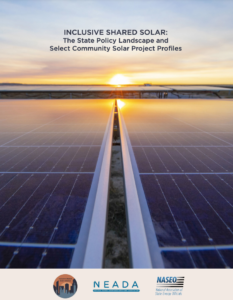Full Title: Inclusive Shared Solar: The State Policy Landscape and Select Community Solar Project Profiles
Author(s): Will Macheel and Cassandra Lovejoy
Publisher(s): National Association of State Energy Officials and National Energy Assistance Directors Association
Publication Date: February 23, 2023
Full Text: Download Resource
Description (excerpt):
Installing solar energy can help reduce household energy costs, increase energy resilience, and stimulate local job growth. Community solar allows households unable to install solar directly on their property to access these benefits through a shared model. While community solar programs have expanded significantly, in recent years many continue to reach primarily wealthier customers. States play a crucial role in the development of community solar markets and, in this capacity, can help minimize the costs and ensure the benefits of solar extend more effectively to low- and moderate income (LMI) populations. Policies at the state level can require or incentivize that a percentage of community solar subscriptions or output be reserved for LMI communities. States can also design community solar programs to encourage participation among LMI customers by adjusting key program elements, such as compensation structures, location requirements, and capacity limits.
State Energy Offices and Low-Income Home Energy Assistance Program (LIHEAP) offices occupy a unique position within the community solar ecosystem. In their roles advising and engaging governors, legislators, and regulators, developing clean energy incentives and programs, and convening a wide array of stakeholders involved in low-income energy programming, State Energy Offices can help shape policies and program requirements to achieve state clean energy and equity goals. Similarly, LIHEAP offices inform policy, develop programs, streamline income qualification processes, and are connected to and can elevate the needs of LMI communities. Together, these two sets of agencies can collaborate to promote inclusive community solar policies and improve access among LMI households at the state level. This report provides an overview of the LMI community solar landscape to help State Energy Offices, LIHEAP offices, and other key stakeholders understand and take advantage of opportunities to expand the reach and impact of community solar programs. It discusses common LMI community solar policy and program considerations and profiles four projects in three different states to show how state policy decisions can impact community solar program design and implementation
